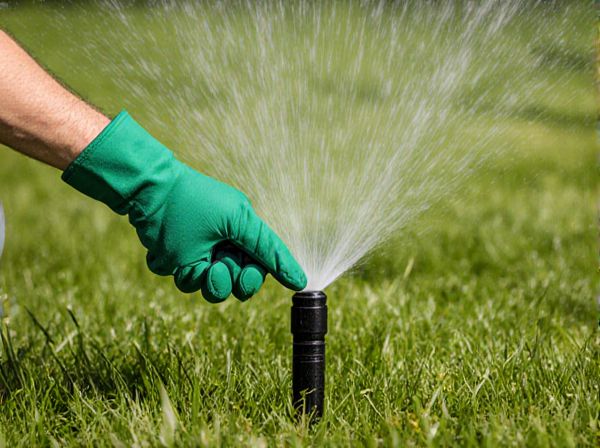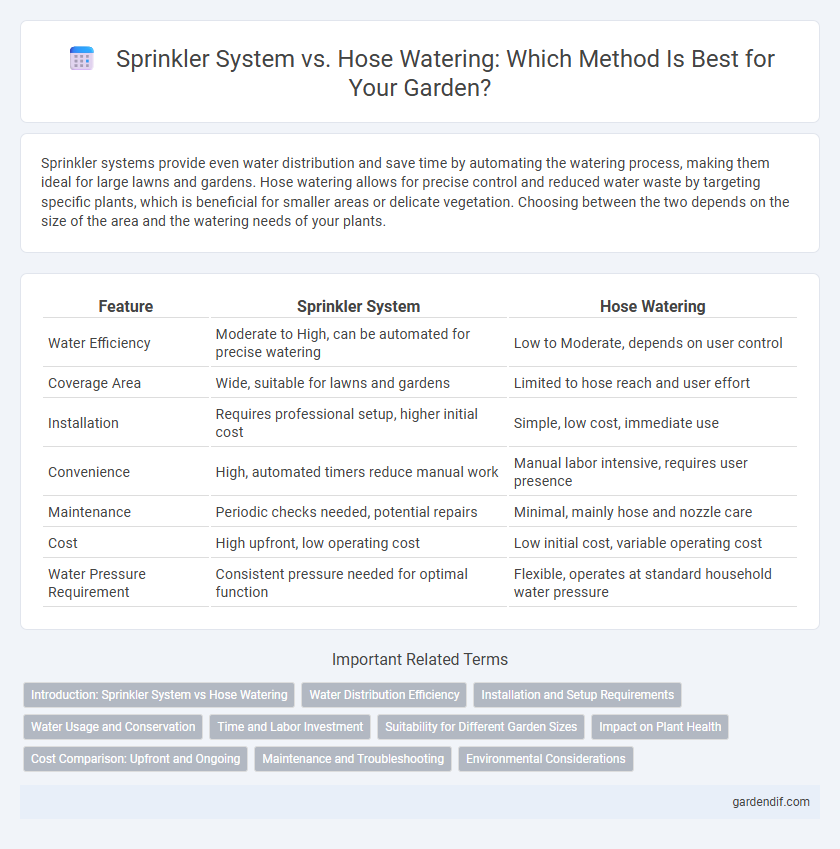
Sprinkler system vs Hose watering Illustration
Sprinkler systems provide even water distribution and save time by automating the watering process, making them ideal for large lawns and gardens. Hose watering allows for precise control and reduced water waste by targeting specific plants, which is beneficial for smaller areas or delicate vegetation. Choosing between the two depends on the size of the area and the watering needs of your plants.
Table of Comparison
| Feature | Sprinkler System | Hose Watering |
|---|---|---|
| Water Efficiency | Moderate to High, can be automated for precise watering | Low to Moderate, depends on user control |
| Coverage Area | Wide, suitable for lawns and gardens | Limited to hose reach and user effort |
| Installation | Requires professional setup, higher initial cost | Simple, low cost, immediate use |
| Convenience | High, automated timers reduce manual work | Manual labor intensive, requires user presence |
| Maintenance | Periodic checks needed, potential repairs | Minimal, mainly hose and nozzle care |
| Cost | High upfront, low operating cost | Low initial cost, variable operating cost |
| Water Pressure Requirement | Consistent pressure needed for optimal function | Flexible, operates at standard household water pressure |
Introduction: Sprinkler System vs Hose Watering
Sprinkler systems provide automated, uniform water distribution ideal for large lawns or gardens, while hose watering offers manual control suited for targeted watering of specific plants. Sprinklers save time and ensure consistent moisture levels, reducing water waste compared to hose watering, which depends on user attention and technique. Choosing between these methods depends on garden size, plant types, and water efficiency goals.
Water Distribution Efficiency
Sprinkler systems provide uniform water distribution by covering large areas with consistent spray patterns, reducing runoff and evaporation compared to hose watering. Hose watering tends to deliver water unevenly, often concentrating flow in specific spots, leading to inefficiencies and potential overwatering. Efficient water distribution in sprinkler systems supports healthier plant growth and conserves water resources effectively.
Installation and Setup Requirements
Sprinkler systems require professional installation or detailed setup, involving underground piping, timers, and zone controls to ensure efficient water distribution. Hose watering demands minimal setup, typically only requiring a hose, nozzle, and access to a water source, allowing immediate use with little technical know-how. While sprinkler systems offer automated scheduling and coverage for large areas, hoses provide flexible, on-the-spot watering without the need for extensive infrastructure.
Water Usage and Conservation
Sprinkler systems use approximately 30% less water than traditional hose watering methods by delivering water evenly across the lawn and minimizing runoff. Advanced sprinkler timers and sensors can further optimize water usage by adjusting irrigation based on soil moisture and weather conditions. Hose watering often leads to overwatering and evaporation loss, making sprinkler systems more efficient for water conservation in landscaping.
Time and Labor Investment
Sprinkler systems significantly reduce labor investment by automating watering schedules, allowing users to save time compared to manual hose watering. Hose watering requires constant attention and manual operation, making it labor-intensive and time-consuming, especially for larger areas. Automated sprinklers enhance efficiency by delivering consistent water application while freeing up several hours weekly.
Suitability for Different Garden Sizes
Sprinkler systems are highly efficient for large gardens, providing uniform water distribution over extensive areas while saving time and effort. Hose watering offers greater control and precision, making it ideal for small to medium-sized gardens or targeted watering of specific plants. Choosing the best method depends on garden size, plant types, and desired watering frequency, ensuring optimal water usage and healthy plant growth.
Impact on Plant Health
Sprinkler systems provide consistent and even water distribution that reduces the risk of overwatering and promotes deeper root growth, enhancing plant health. Hose watering can lead to uneven moisture levels, causing stress to plants and increasing susceptibility to diseases. Optimal watering methods improve nutrient absorption and support robust, resilient plant development.
Cost Comparison: Upfront and Ongoing
Sprinkler systems typically require a higher upfront investment, including costs for installation and equipment, while hose watering demands minimal initial expenses. Ongoing costs for sprinkler systems involve electricity or timer maintenance, whereas hose watering primarily incurs water utility charges and occasional hose replacement. Evaluating long-term efficiency and water usage is essential to determine the most cost-effective option for specific landscaping needs.
Maintenance and Troubleshooting
Sprinkler systems require periodic inspection of valves, nozzles, and timers to prevent clogs and ensure even water distribution, while hose watering demands frequent checks for leaks, kinks, and nozzle functionality. Maintenance of sprinkler systems often involves cleaning filter screens and adjusting spray patterns, whereas troubleshooting hose watering centers on detecting ruptures and replacing worn washers. Both methods benefit from seasonal system flushing and timely repairs to optimize water efficiency and garden health.
Environmental Considerations
Sprinkler systems often use water more efficiently by distributing it evenly across large areas, minimizing runoff and soil erosion compared to hose watering, which can lead to excessive water use and waste. Hose watering typically requires manual operation, increasing the risk of overwatering and water loss through evaporation, whereas automated sprinkler systems can be programmed to optimize watering schedules based on weather conditions. Environmental considerations favor sprinkler systems that reduce water consumption and lower carbon footprints by conserving water resources and promoting sustainable irrigation practices.
Sprinkler system vs Hose watering Infographic

 gardendif.com
gardendif.com